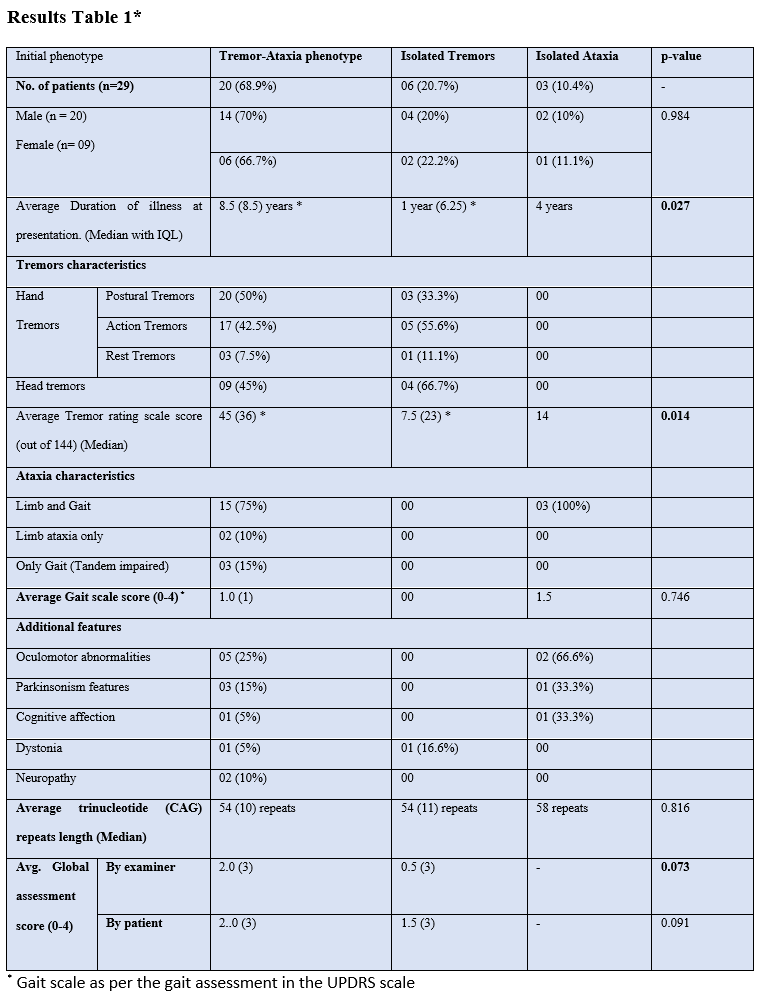Category: Ataxia
Objective: To describe clinical phenotype, manifestations, and assess tremor severity using standard rating scale in genetically confirmed patients with SCA12.
Background: Spinocerebellar Ataxia-12 (SCA12) occurs secondary to a trinucleotide CAG repeat expansion (>43 repeats) within the 5’ region of PPP2R2B, on chromosome 5q31-33, and is most reported from a specific north Indian ethnic caste, known as the Agrawal’s.
Method: A retrospective study in 29 genetically confirmed symptomatic patients from 24 families of SCA-12, visiting our centre from June,2011 to May,2022 (a period of 11 years) was conducted, with thorough documentation of movement disorders in all patients, and applying Fahn-Tolosa-Marin tremor rating scale, standard Gait scores, and Global assessment scales to assess symptom severity.
Results: Out of a total of 29 SCA12 patients (20 males, 9 females), age at onset 35-69 years (mean 49.72 ±2.91), presenting at 1-20 years after their illness onset (mean 7.86±2 years), hand tremors were in 25 (86%) patients, while both tremor and ataxia were appreciable in 20(68.9%) patients (tremor-ataxia phenotype in Table 1*).
Tremors were postural and action in 20 cases, postural only in 3 and action alone in 2 cases. Cerebellar affection in the form of limb and/or gait ataxia was seen in 23 patients.
Parkinsonian features, abnormal eye movements, and dystonia were seen in 4 patients each, while cognitive affection and peripheral neuropathy documented in 2 patients each (Table 1). A tremor-ataxia phenotype was more likely with prolonged illness duration (p-value 0.027), and this group had significantly more tremor severity (p-value 0.024), and a poor global functional disability score. CAG trinucleotide length had no proportional correlation with age of onset, phenotype, tremor severity, or global functional disability scores.
Conclusion: SCA-12 is a rare neurodegenerative disorder with mild to markedly disabling postural and action limb tremors and a variable age of presentation (4th – 5th decade in our study). Ataxia is non disabling in early stages. The presence of rest tremors, parkinsonism, dystonia, cognitive dysfunction, spasticity, and neuropathy in some of our patients widens the possible phenotypic spectrum of the disorder.
To cite this abstract in AMA style:
V. Mathur, A. Shetty, P. Wadia. The phenotypic spectrum and assessment of severity in patients of Spinocerebellar Ataxia-12. [abstract]. Mov Disord. 2023; 38 (suppl 1). https://www.mdsabstracts.org/abstract/the-phenotypic-spectrum-and-assessment-of-severity-in-patients-of-spinocerebellar-ataxia-12/. Accessed December 7, 2025.« Back to 2023 International Congress
MDS Abstracts - https://www.mdsabstracts.org/abstract/the-phenotypic-spectrum-and-assessment-of-severity-in-patients-of-spinocerebellar-ataxia-12/

